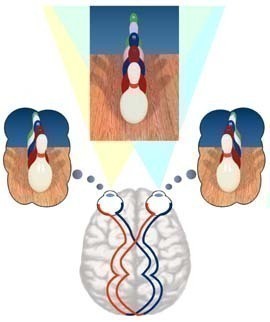The term stereoscopic vision refers to the human ability to view with both eyes in similar, but slightly different ways. This allows humans to judge distance, which develops their ability to have true depth perception. Historically, the human’s ability to view the world through stereoscopic sight has given him/her a significant advantage over entities and animals in the wild that do not possess this capability.
How does Stereoscopic Vision Work?
For people and animals that have stereoscopic vision, each eye sees a similar, but slightly different image. This difference is referred to as retinal or binocular disparity. The brain processes these images in a way that allows the person or animal to slightly see around an obstacle without having to physically move. This process is accomplished by matching the different images and then taking into account the differences in the two images. Although the visual differences are small, the end result is a significantly improved depth perception of one’s surroundings.
The Advantages of Stereoscopic Vision
Most people take their ability to view their surroundings with stereoscopic vision for granted. When a person loses the sight in one eye, it is almost impossible for him/her to grasp depth perception at the same level as when they had sight in both eyes. Stereoscopic vision also helps humans to handle and manipulate small objects with their hands. Animals that have this type of vision can use it to navigate through dense jungle, thus helping to ensure their survival against predators. This same ability helped humans survive in the wild as they could assess threats quickly and accurately. In the modern world, stereoscopic vision enables aviators, surgeons, and car drivers to perform their functions at a high degree of accuracy that would be quite challenging otherwise.
Other Methods Humans Use to Judge Distance
Stereoscopic vision is not the only way that humans judge distance. The human brain also uses the focal distance to an object to estimate distance. The distance is judged based on how the eye must be focused in order to clearly see an object. However, this is not as precise as stereoscopic vision. This method is used in conjunction with stereo sight in order to obtain a higher degree of accuracy in judging distance.
Stereograms
Stereograms take advantage of human stereoscopic vision. Stereograms are pictures that appear to be 3 dimensional (3D) when the human eye views them. The technique relies on each eye perceiving images in a slightly different manner due to the physical separation between them. When the human eye observes two images that are slightly different, the brain perceives them as a single 3D image, thereby creating a stereogram.
Who Invented the Stereogram?
Charles Wheatstone first discovered the stereogram in 1838. He constructed the device by using a combination of mirrors and prisms that allowed the human eyes to see a 3D image when observing two 2D pictures. Oliver Wendell Holmes Sr, who followed up on Wheatstone’s work, created a stereoscope in 1861 that did not use mirrors and was significantly less expensive to produce.
Types of Stereograms
Several stereoscopic imaging techniques are used to create a stereogram today. These include anaglyph images, random dot stereograms, autostereograms, SIRDS, and the wigglegram. Anaglyph images combine two stereo pictures taken from slightly different viewpoints, so that when they are viewed with anaglyph glasses they appear to be a 3D image. Random dot stereograms employ two stereoscopic images that, when viewed with a properly designed viewing device, display a hidden 3D scene or image. Autostereograms display a 3D image through a single computer generated picture by repeating a narrow pattern from left to right in the picture. When the viewer decouples the eye convergence by focusing on the picture, the brain is tricked into seeing a 3D picture. SIRDS is a type of autostereogram that slightly alters each repeated pattern in the picture that creates a hidden image. This hidden 3D image is not viewable until the proper viewing technique is used. Finally, the wigglegram is a type of animated computer image that allows human eyes to see a 3D picture without using glasses and only contains a single image.
Stereogram Uses
Historically, stereograms were used for entertainment starting in the late 1800s. Throughout the 20th century, they were used to create 3D movies and posters. More recently, the technology has been used in space exploration to generate composite anaglyph images that can be viewed with red/cyan filter glasses. The Mars Exploration Rover uses two cameras to create scientifically useful stereograms of the planet’s surface. In the medical field, eye doctors use stereograms while treating accommodative disorders and binocular vision. Finally, stereograms are used to visualize aerial photographs when analyzing terrain.




N M
I asked the question (in a Forum last year) .. “Can 3D Glasses be used by people with no sight in one eye, or do you need full vision in Both Eyes?”. ….. The response stated .. “That it will work with just the one eye for the most part, however the lack of Stereoscopic 3D can occasionally become an issue depending on what you are viewing”. It also recommended doing a google search to read some first hand accounts via forums online.
dheenadhayalan
TNO test
esjay
This was very helpful, but…
“When a person loses the site in one eye, it is almost impossible for he or she to regain their full ability to grasp depth perception to the same level as when they had site in both eyes.”
That should probably be changed to “sight”?
🙂
Will.Spencer
Obviously we’ve been spending too much time with web “sites”. 😀